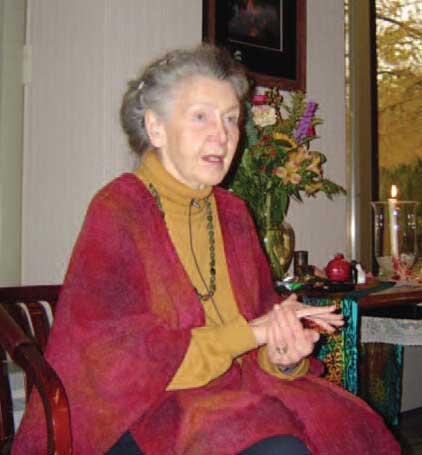
Woodman
“The true feminine is the receptacle of love. The true masculine is the spirit that goes into the eternal unknown in search of meaning. The great container, the Self, is paradoxically both male and female and contains both. If these are projected onto the outside world, transcendence ceases to exist. The Self—the inner wholeness—is petrified. Without the true masculine spirit and the true feminine love within, no inner life exists…. To be free is to break the stone images and allow life and love to flow.”
Marion Woodman, Addiction to Perfection: The Still Unravished Bride1
Jungian analyst Marion Woodman believes that centuries of “patriarchal thinking” have stripped the soul from our inner and outer lives and placed the world in grave danger. In talks, workshops, and BodySoul Rhythms intensives in Canada, the United States, and Europe, she has urged us to engage with the unconscious energy that erupts beneath the surface of our best intentions, sending us where we may not want to go. Her message is articulated in such books as Addiction to Perfection, The Pregnant Virgin, The Ravaged Bridegroom, Conscious Femininity, Leaving My Father’s House, and Dancing in the Flames. She is also famed for her practical work connecting the human body to soul and spirit. As she explains in Conscious Femininity, “To feminine consciousness, the spiritual and the physical are two aspects of one totality. Spirit confirms body, articulates body’s wisdom…. ‘As above so below’ translates into ‘as in the head, so in the belly’; the two are simultaneously present, not dialogically opposed.”2
I first encountered Woodman’s work in my early fifties when her second book, Addiction to Perfection: The Still Unravished Bride, had just been published. Intrigued by the title, I brought it with me on what was supposed to be an idyllic summer vacation by a lake in Maine. Her message, that it’s easier to work at being better than you are than to be who you are, forced me to admit for the first time to a demanding witch and a helpless Ophelia lurking in my depths. Thus began a thirty-year journey into a nether world of psyche in search of the conscious feminine—the heart energy that holds presence. (By feminine and masculine, Woodman means not gender but an energy as ancient as that of the Taoist yin and yang or the Hindu Shakti and Shiva.) Woodman herself experienced a radical turnaround at age fifty, quitting her job as a Canadian high-school English teacher and fleeing to India in search of help for illness and pain. The daughter of a United Church minister, she was both shocked and inspired by a culture whose psychic and spiritual energy were so different from her own. She then embarked on a Jungian analysis in England, and finally trained to become an analyst at the Jung Institute in Zurich.
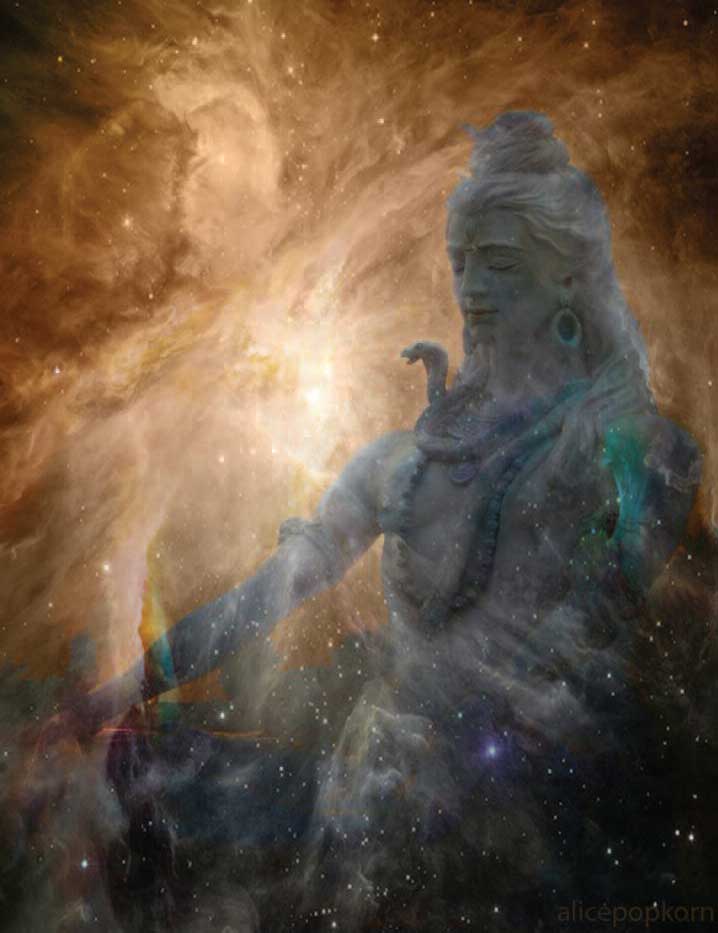
The Redemption of Matter
“As consciousness develops, the body will act as donkey for only so long. Men as much as women need to know that their soul is grounded in their own loving matter. ‘This is who I am. Every cell in my body tells me this is of value to me—not to my persona, to me.’ That is the container whose feeling can be trusted because it is grounded in reality.”3
When she first walks into a room, Woodman appears rather diminutive, even shy, but as soon as she begins to speak her presence amplifies and her fiery honesty magnetizes the audience. Then, in a question-and-answer exchange, she enters a state of intense listening, so that the questioner feels that she and Woodman are alone together despite the many people in the room. That sense of attenive intimacy was present in the workshops and intensives I attended, where each day progressed in a balanced rhythm befitting the title BodySoul Rhythms.
We would spend mornings discussing psychology, participants’ dreams, and the current world crisis, while afternoons were dedicated to bodywork in a large empty room. First we lay down on the floor to experience the quiet release of letting everything go. When sounding began, led by Ann Skinner, head of voice at the Canadian National Theatre School, we listened to our own voices from deep within. Next came slow exploratory movements from the core of ourselves as Mary Hamilton, dance professor at the University of Western Ontario, invited us into gentle instinctive movements. After that, we danced alone, in pairs, or in exercises like the Dance of Three, allowing our dream images to lead us into action. In the evenings there might be artwork or the making of papier-mâché masks, which we modeled from our own faces. If we made masks, the week would be climaxed by a mask party, as we studied the manifestations in ourselves and each other of the hidden complexes the masks represented. Woodman’s strong holding presence witnessed our explorations, which often teetered on a delicate balance. As she advised us, “When you’re dealing with archetypal energy, keep one foot on the gas and one foot on the brake!” Finally, before we returned to a life that for the moment seemed very far away, came the time for sacrifice. What would we give up of our old attitudes and assumptions in order to receive the new and make it our own? Woodman made it clear that sacrifice was always necessary to honor what had been discovered, and that the hardest part of the task of real change would be “to take the treasure home.”
This emphasis on the primacy of bodywork resulted from her earlier efforts to deal with intense pain and illness. In search of respite, she would wrap herself in a blanket and curl up on the floor into a cocoon of safety, then allow movement to begin from deep within. That’s how she discovered that physical movement awakens energies lying dormant or even imprisoned in other parts of our nature. As one goes attentively into movement, inviting the psyche to offer images, or responding to an image from a recent dream, energy that had been blocked or hidden away in unvisited parts of oneself can surface and interact with the “normal” self. By working daily with dream imagery, dance, and movement, as well as by listening to the sounds of one’s own voice, the metabolism of the body, Woodman believes, can be changed: “Perception is opened to other levels…. If soul and imagination are surrendered to God and Goddess, then it is … the real purpose of being alive. For me the creative masculine is the surrendered imagination. My conscious feminine container surrenders to that creative masculine. Then life is intercourse with the Divine. Out of that union comes the Divine Child, the new consciousness.”4
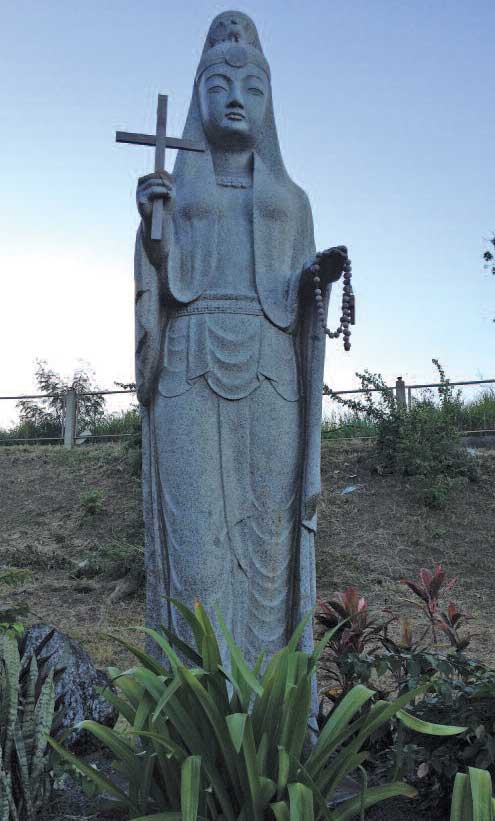
The Sacred Feminine
“Soul-making is allowing the eternal essence to enter and experience the outer world through all the orifices of the body … so that the soul grows during its time on Earth. It grows like an embryo in the womb. Soul-making is constantly confronting the paradox that an eternal being is dwelling in a temporal body. That’s why it suffers, and learns by heart.”5
If our bodies are sacred vessels, the energy of the conscious feminine is divine. In The Pregnant Virgin: A Process of Psychological Transformation, Woodman calls attention to the Black Madonna as a bridge between body and spirit. And in Dancing in the Flames: The Dark Goddess in the Transformation of Consciousness, she writes: “Although she takes many forms, this goddess—sometimes a Black Madonna or an Asian or Indian Madonna—always carries authority. She guides and advises and acts with absolute clarity…. She is blunt, neither indulgent nor sentimental. She demands embodiment. Living in the creative intercourse between chaos and order, she calls us to enter into the dance of creation.”6
In Woodman’s approach to the divine feminine, soul is the connecting link between the body and the divine, and the inner marriage, referred to by Jungians as the high point in the individuation of a human being, is between spirit and soul. Her personal goddess is Sophia, whose loving wisdom she celebrates every morning with prayers and offerings. As she explains it, wisdom combines experience with knowledge, connecting body with spirit through soul. By linking body experience with ancient knowledge, she believes we can build a subtle body within our physical body: “Without the consciousness of Sophia’s wisdom illuminating not only our body, but the body of creation, we lack the crucial connection to our own feeling. We judge with our minds and forget we have hearts, lungs, spleens and bowels. Then we fail to temper our winged spirit with human limitations. Without embodied soul, spirit cannot manifest through human feeling. It flies like an angel with no place to land, archetypal energy that merely swoops through, leaving the body a burned-out shell demanding whatever perverted solace
it can find.”7
Loss of Soul and Hope of Consciousness
“Individuation begins with the painful recognition that we are all orphans. And the liberating recognition that the whole world is our orphanage.”8
Whether referencing goddesses, dreams, or the need to come back to our presence in the body, Woodman’s work has always hewed closely to whatever was happening in the world. In every talk and workshop she has brought our attention to the suffering that exists on a global scale, and called on us to play our part in the vision of one world, one larger community. If the modern world has lost both its grace and its grounding because of the lack of connection to our true feminine nature, then only by suffering the presence of the forces that oppose our sincerest efforts to be true to ourselves will we find safe harbor:
“If we have no bridge to the unconscious depths that drive us, our rational attempts to correct our situation are merely Band-Aids,” she writes in Conscious Femininity. “They work only so long as we remain cut off from the living fire inside. When that fire blazes forth, our Band-Aids go up in smoke.”9
If we wish to embody the conscious feminine, we can start by acknowledging the dire threat of loss of soul, then accept the task of rebirthing the feminine—matter—and receiving the masculine—spirit. And to help us strip off our Band-Aids, Woodman invites us to live beyond the ego world of either/or duality, to move “out of chronos, or chronological time, into kairos, the eternal moment. This timeless moment is characteristic of all acts of creation, where the tension of opposites is resolved into a new unity, a higher consciousness.”10
Rather than waging war on what is foreign, she urges us to see how the conscious feminine depends on recognition by the masculine, just as the masculine depends on being seen by the feminine. That way, “God and Goddess, forever being discovered through the work of individuals, unite us all in a global community we are only now beginning to discover…. The ‘us’ who will one day live in the center of the global mandala will be both masculine and feminine, united in a partnership of equals.”11
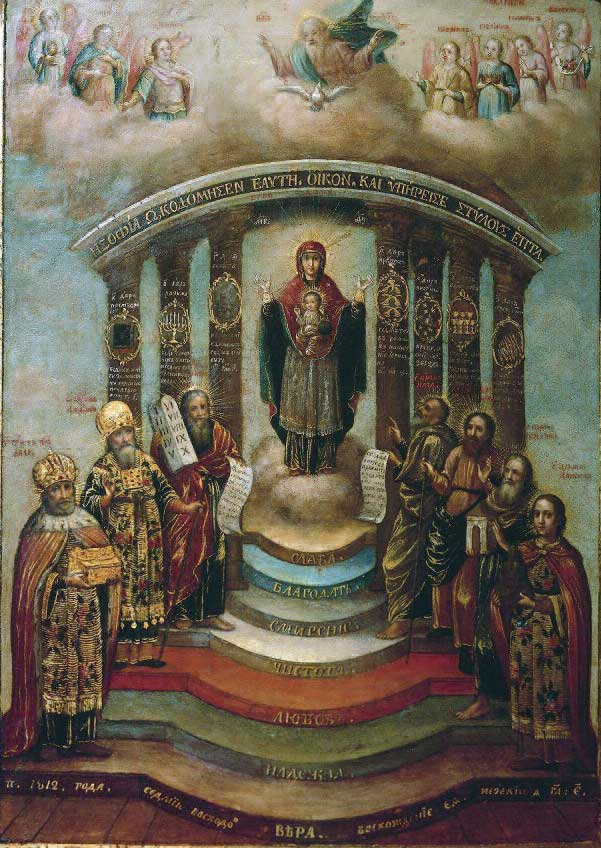
Rule of Power or
Rule of Love?
“The opposite of power isn’t weakness. The opposite of power is love.”
In an interview in the Summer 1987 issue of Parabola on Addiction, Woodman pointed out that for thousands of years, from the early Greeks to today’s blockbuster movies about superheroes, the idealization of the hero has dominated the West. However, hidden in the dark side of the hero image lurks an unconscious desire for power, which can be seen in the fixed attitudes of matriarchal and patriarchal thinking. An example is the mother archetype, which can nurture in its positive aspects or secretly devour its young. Positive mother energy will encourage our efforts, but the influence of the negative mother runs rampant in our culture—in self-doubt and the suspicion that we’ll never make it, never quite be able to please the parental authority figure hidden deep inside us. Woodman postulates that we are becoming more aware of the unconcious negative influences of the patriarchal and matriarchal forces that dominate our society, and can now break away, moving into an adolescence that will bring physical, emotional, and spiritual growth to the world, along with the inevitable conflict and suffering that is now taking place.
At the Omega conference on Women and Power in 2004, Woodman reiterated the world’s urgent need for the conscious feminine: “We can no longer say I am right and you are wrong,” she affirmed. “It is the feminine principle that can bring a whole different thinking process to the patriarchy as we have known it…. Instead of breaking things off into parts, it would say, ‘where are we alike? How can we connect? Where is the love? Can you listen to me? Can you really hear what I am saying? Can you see me? Do you care whether you see me or not?’… What I’m talking about here is presence and relatedness.”
The Conscious Feminine as a State of Being
“Live your own life and not the one projected on you.”
Woodman often speaks of the divine feminine in three aspects—virgin, mother, and crone. The conscious mother gives birth to the virgin within us. She is one-in-herself and acts not for power or from the wish to please, but because she is true to her own nature. It is she who carries the new consciousness. The crone, related to the word crown, evolves out of both conscious mother and virgin. She represents detachment and fearlessness in spite of the fact that she has lost her ordinary power or influence. She may even have to be cared for and supported in many ways, but she is free to be herself, to discover a new presence in herself. Her task: to cut through the clutter and tell us the truth, whether we like it or not!
When I interviewed Woodman in 2005 for an article in Parabola’s Coming to Our Senses issue, she elaborated on the feminine as a state of being. “Whereas the patriarchal lives in either/or, the feminine lives in both/and, enjoying the process, not glued on the product, and moving with presence…. All of us need the masculine, not the patriarchy but the masculine discrimination, discernment, capacity for clarity, and the courage to use a sword when necessary. Some things have to be cut out of our lives and courage and strength is involved in that masculine energy as well as the capacity to come into the world. It would be wonderful to bring those two together in one person, where you have the being, honoring whatever is happening, and the discernment.”
As we sat facing each other she gestured toward the space between us, saying, “Matter is as conscious as spirit, and for me the space between any two people holds molecules that carry our presence. But most of us fail to inhabit our bodies and consequently fail to project that presence. Not present where we are, we’re either behind or ahead of ourselves, not seeing, hearing, smelling. And most of us are grappling with unconscious negative feelings, so there’s animosity where there could be numinosity—the glory of knowing we are loved, as that positive energy pours into us from the other person.”12
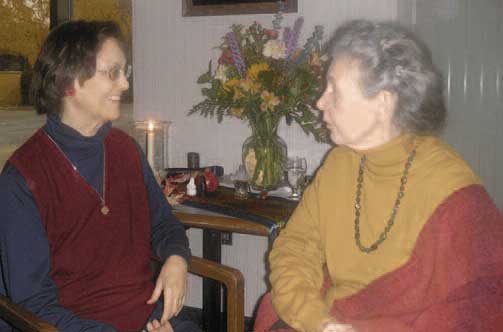
In June 2007, when Woodman received a lifetime achievement award from the University of Toronto, she compared the journey of life to a spiral staircase that goes both up and down, reminding us again to “Hold that place, that still point between the tension of the opposites. It’s the central core that holds the spiritual power. You never, never come back to the same place. Avoid compulsive repetition. Life is not a circle but a spiral around a central place, and we are working our way up and working our way down. Bad times give us strength to move into good times with a whole new vision of what life is about.” She shared her thoughts about death in an interview with The Common Boundary: “When you face death, when you know you’ve lived life, lived it to the fullest, you’re ready to go on with a new chapter. If you haven’t lived it, if you’ve never been here, never been present, I’m sure you’ll be terrified of death because your whole life has been an absence. You’ve missed it. Well, by heaven, I don’t intend to miss mine!”13
Though now retired, Woodman’s work on the Conscious Feminine continues through the Marion Woodman Foundation and with the many women who attended her Leadership Training Programs. (For more information
about workshops and intensives, go to https://mwoodmanfoundation.org.).♦
1 Marion Woodman, Addiction to Perfection: The Still Unravished Bride, Inner City Books, Toronto 1982, 188.
2 Conscious Femininity, Inner City Books, Toronto 1993, 8.
3 The Ravaged Bridegroom: Masculinity in Women, Inner City Books, Toronto 1990, 181.
4 Nancy Ryly, The Forsaken Garden: Four Conversations on the Meaning of Environmental Illness, Quest Books, Wheaton, IL 1998.
5 Conscious Femininity, 134–35.
6 Dancing in the Flames: the Dark Goddess in the Transformation of Consciousness, (co-authored with Elinor Dickson), Shambhala, Boston 1996, 1.
7 The Ravaged Bridegroom, 177–78.
8 Leaving My Father’s House: A Journey to Conscious Femininity (co-authored with Kate Danson, Mary Hamilton, Rita Greer Allen), Shambhala, Boston 1992, 354.
9 Conscious Femininity, 9.
10 Dancing in the Flames, 63.
11 Conscious Femininity, 11.
12 Parabola, Coming to Our Senses, Spring 2005.
13 The Common Boundary, Vol 7, no. 2, March/April 1989.
Patty de Llosa, Marion Woodman and the Search for the Conscious Feminine: Guidance from an esteemed Jungian teacher from our “Divine Feminine” Issue (Vol. 41, No. 1). This issue is available to purchase here. If you have enjoyed this piece, consider subscribing.
